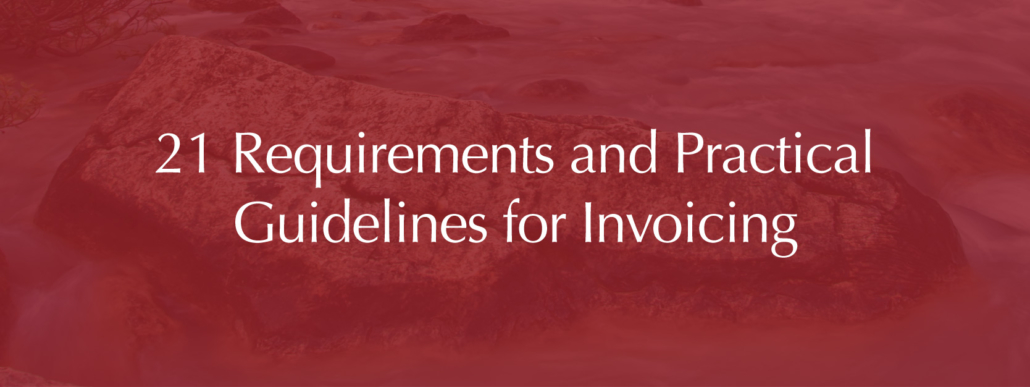21 Requirements and Practical Guidelines for Invoicing

Issue of sales invoices concerns all businesses – we all issue invoices and receive invoices. But what should one sales invoice look like? We go through the most important legal requirements and practical recommendations, which are good practices to keep in mind when preparing sales invoices.
1. A sales invoice can only be issued by a company or self-employed person, invoice cannot be issued by a private person. If you wish to purchase services or goods from a private person, you must enter into a contract, which is also an expense document.
2. VAT shall be added to the sales invoice only if the seller is liable for VAT. Buyer status (VAT liable or not) is here not relevant.
3. VAT invoice must be issued within 7 calendar days from the date of dispatch of the goods or provision of the service. Regular services are usually billed after the end of the month.
4. There is no direct time limit for invoicing without VAT but the normal transaction requirement expires in 3 years. This means that a situation might occur where you are billed for, for example, the previous year, and if the service was actually performed or the goods were delivered to you, you would also be obliged to pay for it afterwards.
5. In certain cases, the buyer may also invoice himself, if the parties agree to do so. This is especially useful in cases where the buyer, not the seller, has detailed information about the content and details of the transaction. The VAT Act requires that, in order to use such a solution, there must be an agreement between the seller and the buyer whereby the seller gives his consent to the issue of invoices by the buyer. The invoice must also be marked “self-billing”.
6. The minimum requirements for a sales invoice without VAT shall include at least the information on the economic contents of the transaction, time of transaction and figures – such as quantity, price and amount.
7. No invoice shall be issued to a private individual unless he requires so. If the buyer is an economic operator, invoice number and the parties data, such as name and address or registry code, must also be included in the invoice.
8. It is good practice for the invoice to include a due date. In Estonia, the due date is given as a date, in some countries as a day (e.g. 21 days). The usual payment deadline is 7-21 days, and up to two months for large companies. When you make an offer to a large company, always ask what the payment term is. If necessary, use factoring in cash flow stabilization.
9. It is also advisable to include the business registration number and contact details of the company such as telephone, email and account number. Also include a note on the invoice if it has already been paid and, if the invoice is for an order, the order number. These are all things that no law requires, but if you want your bill to be paid quickly by a large company or accounting firm, you need to follow them.
10. In addition, the VAT identification number must be indicated on the invoice. In some cases, you will also need to include the buyer’s VAT number (especially if you are applying 0 VAT).
11. When issuing invoices outside of Estonia and using reverse charge or self-billing, you will need to add a reference to your invoice, such as reverse charge, self-billing or reverse charge.
12. To keep your bills paid, hedge your risks well before the sale by establishing a good credit policy with the company and thoroughly checking the background and payment behaviour of each new customer based on how much credit you can sell.
13. A credit note may be issued only if the original invoice had significant mistakes or the service provision or delivery of goods did not actually take place. An outstanding invoice cannot be written off as a credit note, it must be written off with VAT.
14. If the invoice has not been received for a longer period (already several months) and there are reasons to believe that it will not be received, the invoice shall be classified as unlikely. If the buyer is bankrupt or liquidated, or if it is disproportionately expensive to recover the amount of the invoice, the invoice is classified as irrecoverable and written off. A written justification must be given, otherwise it is considered a non-business expense, subject to income tax.
15. The sales invoice issued should not be in Word, Excel or image format, even if it is compiled in one of these programs. Manual invoices must be converted to pdf or better, sent directly from an accounting program or using an e-invoice solution.
16. Generally speaking, it is best to manage everything related to sales invoices today in a cloud-based accounting program. First, it is convenient because many lines are generated automatically and do not have to be entered manually. Secondly, you can instantly track receipts in many programs, as well as remind customers who do not pay your invoices, etc.
17. Since 01.07.2019, only e-invoices are accepted by the public sector, meaning that public authorities (including schools, hospitals, etc.) will be no longer able to submit a regular PDF invoice. If you have not yet transitioned to e-invoicing in your company, you should take the lead and seriously consider it.
18. Many businesses fear that switching to e-invoicing will be difficult. In fact, there is nothing unsurpassed here, you just need to modify some processes and note in the business register company portal that you are ready to receive e-invoices and have a contract with an operator (3 biggest operators in Estonia are Fitek, Omniva and Telema).
19. It is smart to use the purchase invoice management environment in the e-invoicing environment to verify invoices. This is convenient if you have multiple people in your invoice verification process, or if you are buying a service from an accounting firm, for example – the accountant will send you an invoice for review, you will add your own confirmation and project information.
20. You can continue to receive invoices in PDF format by switching to e-invoices, but they must be digitized. Digitization means that the PDF invoice sent to you will be converted to an e-invoice. Digitization is carried out by all major operators.
21. When you get e-invoicing going in your business, you gain considerable time as both buyer and seller – the invoice moves in minutes, like an SMS, and neither party has to re-enter anything. This gives a lot of working time for both the seller and the buyer, and you can use the time for other important activities.
Practice shows that errors occur in compiling sales invoices when they are made manually, manual invoicing is also quite time consuming. All in all, it would be easier for us all to process purchase invoices if we used more e-invoicing. In Finland, 80% of all purchase invoices are already sent as e-invoices. We should set the same goal for Estonia.

Leave a Reply
Want to join the discussion?Feel free to contribute!